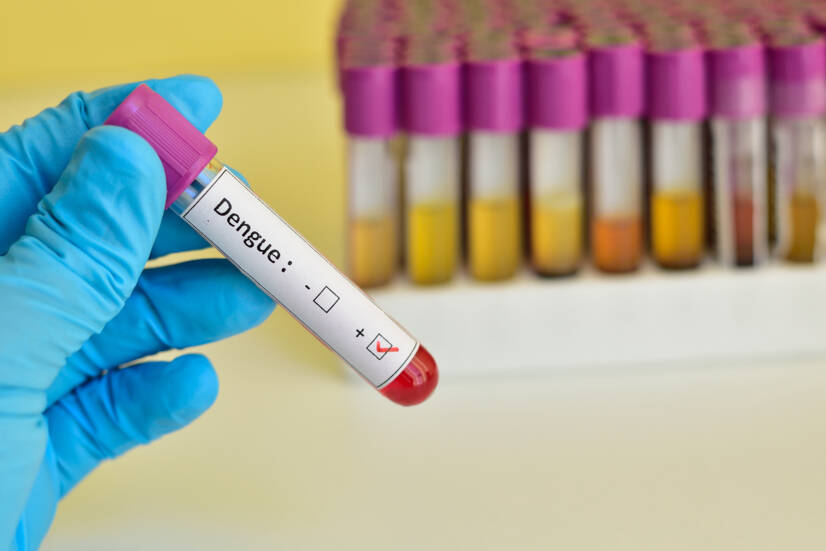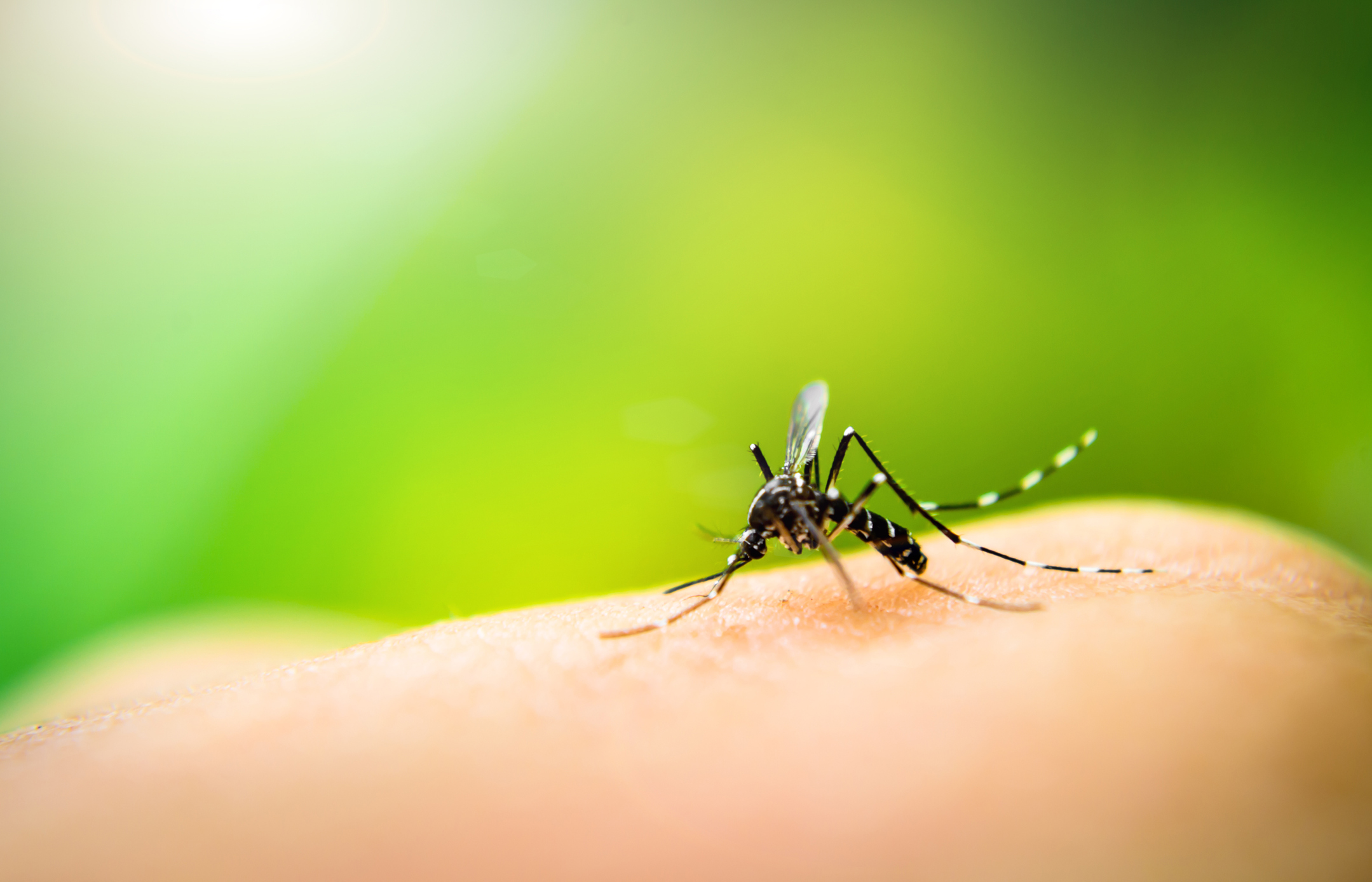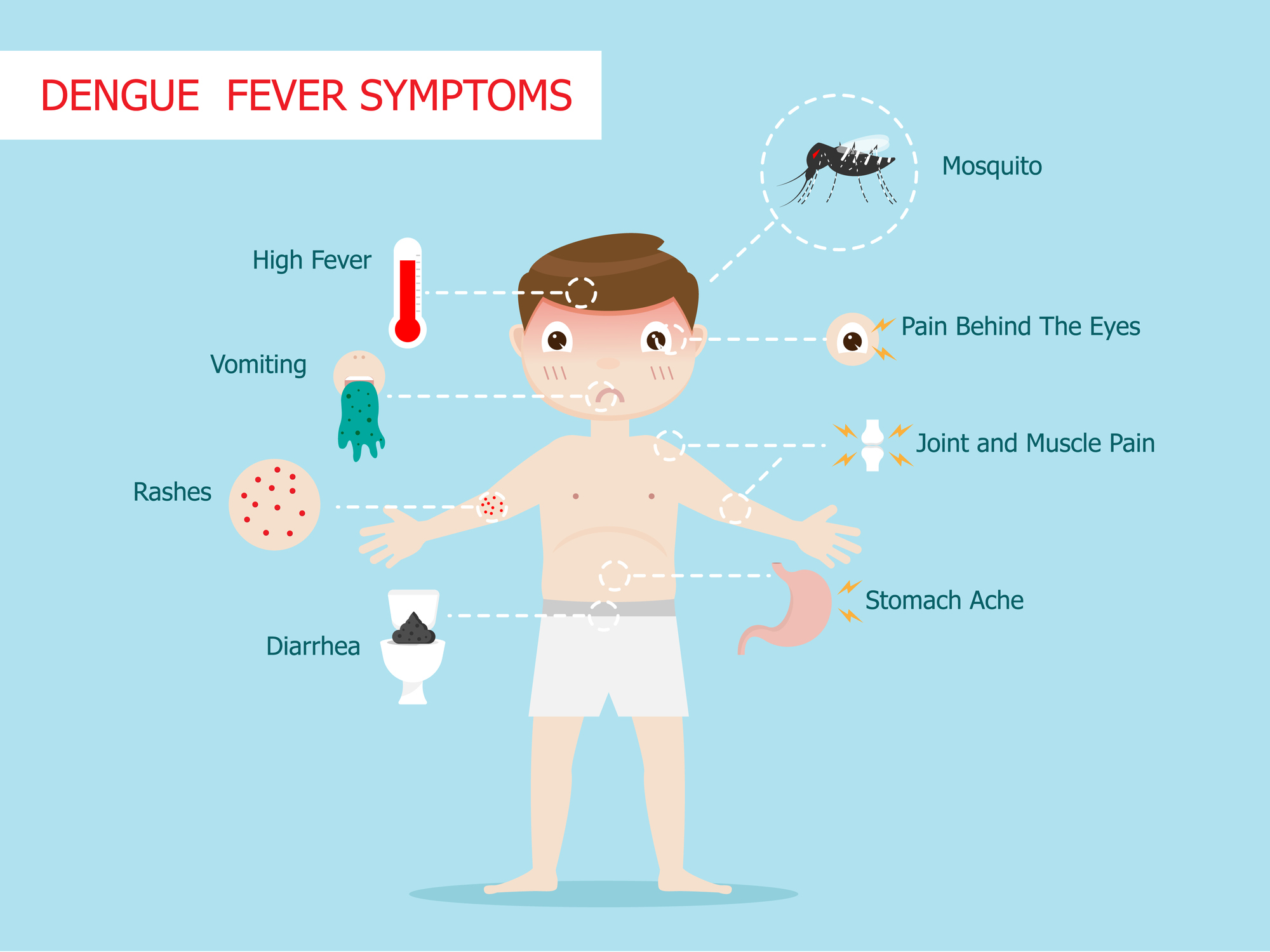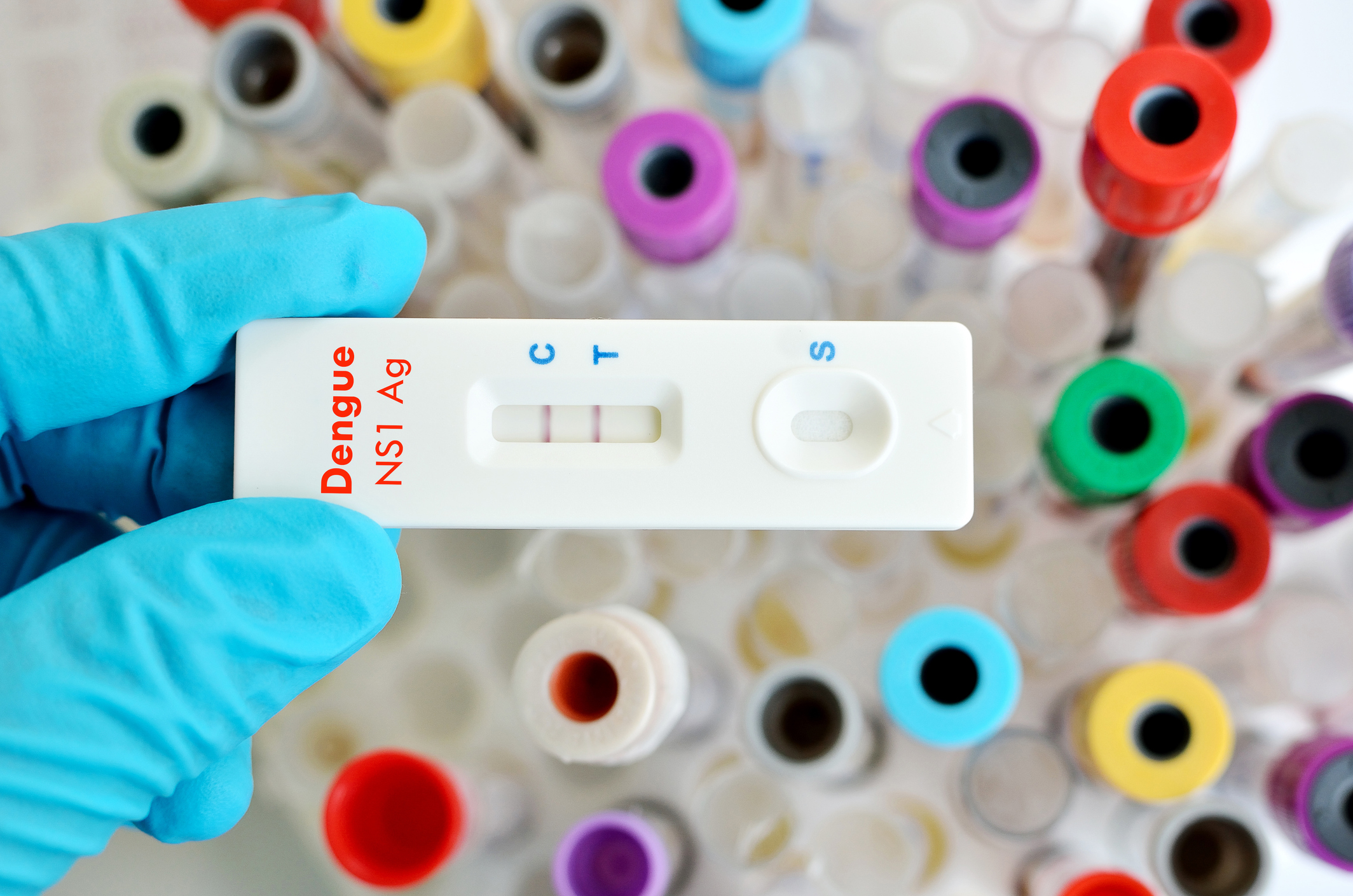- solen.cz - Patient with classical dengue fever
- prolekare.cz - Dengue fever
- prolekare.cz - Cases of dengue fever in Czech workers employed in the Maldives
- prolekare.cz - Dengue fever
- prolekare.cz - Dengue threatens the Czech Republic! The number of infected is growing
- prolekare.cz - Imported infections from exotic countries
- who.int - Dengue and severe dengue
- sciencedirect.com - Dengue virus
- webmd.com - Dengue fever
Dengue fever: what are its causes and symptoms? (+ Transmission and mosquitoes)

Dengue fever is transmitted by mosquitoes. What are the symptoms and how to protect yourself?
Most common symptoms
- Muscle Pain
- Malaise
- Abdominal Pain
- Headache
- Joint Pain
- Limb pain
- Eye Pain
- Fever
- Diarrhoea
- Bone Pain
- Rash
- Bleeding gums
- Bleeding
- Indigestion
- Nausea
- Buds
- Fatigue
- Vomiting blood
- Vomiting
- Reddened skin
- Winterreise
- Enlarged lymph nodes
- Increased body temperature
Characteristics
Four serotypes of dengue virus are known (DENV-1, DENV-2, DENV-3 and DENV-4). Infection with one serotype confers long-term immunity against it, but not against the other serotypes.
The incubation period is 4 to 10 days.
Many of us think that dengue fever occurs only in certain countries. Dengue fever has been confirmed in more than 100 countries worldwide. It is estimated to threaten approximately 40% of the human population.
Approximately 43% of dengue cases have been reported from the Western Province of Sri Lanka. The highest number of reported cases comes from the Colombo District (18 186).
Other areas include:
- Gampaha (12,121)
- Kurunegala (4 889)
- Kalutara (4,589)
- Batticaloa (3,946)
- Ratnapura (3898)
- Kandy (3853)
Approximately 50 to 100 million cases of dengue fever are reported annually in endemic areas, of which 250 to 500 thousand cases develop severe haemorrhagic fever.
Most patients have no symptoms. Symptoms of the disease vary. Dengue fever may present as a mild febrile illness or as haemorrhagic fever. In the worst case, dengue shock syndrome may occur.
In addition to endemic areas, cases of dengue fever have been reported in some European countries (e.g. Germany, UK, Hungary, Poland, Croatia). These cases were probably imported.
What factors are involved in the spread of the disease?
- Increase in world population
It is estimated that the urban population will increase by 12% by 2050. By that time, up to 90% of the urban population will live in Asia and Africa.
These areas are characterised by poor infrastructure, poor health systems and high levels of poverty. These conditions are ideal for the spread of viruses.
- Increased interest in travel
Nowadays, getting to the other side of the world is no big deal. It is estimated that the number of travellers will double within 20 years.
In the summer season, people seek out various exotic countries for their relaxation. Increasingly, people are also seeking out such exotic places in the winter months. It is in these areas that there is a high risk of contracting diseases that are not found in our latitudes.
- Animals
Approximately 61 % of the 1415 species of infectious pathogens also pose a risk to humans. They are transmitted from animals to humans. The sick human is the last link in the chain of infection. The increased number of domestic animals also has a significant impact on this situation.
- Climate change
Climate change affects human health in two ways:
- Directly - the physiological impact of heat and cold
- Indirectly - changed human behaviour (forced migration), increased incidence of food-borne and vector-borne diseases, flooding, etc.
Causes
The causative agents are 4 related types of dengue virus belonging to the genus Flavivirus and the family Flaviviridae. Flaviviruses are spherical in shape. Their size ranges from 40 to 60 nm. Despite their size, they can cause serious health complications.
This genus includes the causative agents of the following diseases:
- yellow fever viruses
- Japanese encephalitis
- West Nile fever
- Zika virus
- tick-borne encephalitis
The main vectors of the dengue virus are various species of mosquitoes of the genus Aedes (Aedes aegypti and Aedes albopictus). The Aedes aegypti mosquito is also known as the Asian tiger mosquito, a name given to it because of its striped colouring.
The Aedes aegypti mosquito is small compared to other mosquitoes, with a body size of 3 to 4 mm. Despite its size, it is almost unnoticeable. It can be recognised by the white lines on its black body. It has white rings on its legs.
This mosquito lives for several months. It has a sophisticated egg-laying system. It lays them separately, which helps it expand its territory. The females are mainly responsible for spreading disease.
The male feeds only on nectar.

What diseases can mosquitoes carry?
The Aedes aegypti mosquito is a known vector, particularly of the yellow fever arbovirus and dengue fever. The flood mosquito (Aedes vexans) carries the tick-borne virus that causes 'valentine fever'.
Some mosquito species can also passively transmit Lyme disease.
Symptoms

In general, there are 4 forms of dengue fever:
- Form: inapparent dengue fever.
This form is considered the most common type of the disease. It occurs mainly in children. Patients usually show no symptoms. In some cases, minimal symptoms of the disease may appear.
It is estimated that approximately 80% of children in at-risk areas suffer from this form.
- Form: classical dengue fever
The symptoms of dengue fever are similar to more severe influenza. They last approximately 2 to 7 days. The typical symptom is a fever of 38 to 41 °C accompanied by 2 of the following symptoms:
- severe headache
- pain behind the eyes
- nausea
- vomiting
- swollen lymph nodes
- muscle and joint pain
- rash
Even in the case of mild disease, the recovery period is long. It may take up to several weeks. Patients may experience lack of appetite, fatigue and depression during the course of the disease.
- form: haemorrhagic (bleeding) form of dengue fever
In some cases, a severe form of dengue fever, called haemorrhagic dengue fever, can occur. This form can cause death. Typical symptoms include
- severe abdominal pain
- persistent vomiting
- rapid breathing
- bleeding gums
- the presence of blood in the vomit
- fatigue
- restlessness
Neurological complications occur with this form. Hypotension and hypovolaemia (a reduction in the total amount of blood) may also occur. Repeated infections put people at greater risk of severe dengue fever and shock syndrome.
- form: dengue shock syndrome
This form may present as initial shock with signs of circulatory failure.
Diagnostics

Diagnosis is based on clinical symptoms. Another component is the patient's travel history. One important step in the correct diagnosis of the disease is to distinguish dengue from other fever-related diseases:
- other arboviruses
- influenza
- malaria
- typhoid fever
- leptospiroses
- other acute febrile illnesses
PCR and serological tests are used in the laboratory.
Course
- genetic factors
- age
- race - whites have a higher risk of developing more severe forms of the disease than blacks
- pregnancy - pregnant women infected with dengue fever have a higher incidence of fetal malformations
Dengue fever occurs in 2 phases:
- benign form of dengue fever
This form is without complications. The first manifestations of the disease include:
- high fever
- chills
- headache (especially behind the eyes)
- muscle pain
In the later stages, a generalised lymphadenopathy appears. The lymph nodes are painful on pressure. The fever lasts about 2 to 3 days. After this time, it decreases and rises again (lasts 3 to 6 days).
In about half of the cases, a rash may appear on the face. Later, a rash may be seen on the trunk and extremities. The rash in dengue fever resembles that of the rash of the rashworms. Sometimes they may be confluent as in scarlet fever.
Dengue fever lasts, at best, 7 to 10 days. In the blood count, we observe a low white blood cell count (leukopenia) with relative lymphocytosis (high lymphocyte count), platelet deficiency (thrombopenia) and elevated serum aminotransferase values.
- Dengue haemorrhagic fever
If the patient overcomes the benign form of dengue fever, he or she will acquire only limited immunity. The patient may become infected with another serotype of the disease. Re-infection often takes the form of haemorrhagic fever, which can lead to a life-threatening condition.
In the first days, dengue haemorrhagic fever manifests itself as a benign form of the disease. After three to seven days, there is a sharp drop in blood pressure, the patient is restless, experiences abdominal pain and vomits.
Petechiae appear on the skin. Bleeding occurs in the digestive tract or genital organs. The patient develops hypovolemic shock.
Up to 40 % of patients with haemorrhagic dengue fever die if shock occurs.
How to protect yourself from mosquitoes?
Prevention is the first priority. This focuses primarily on fighting mosquitoes.
- Rule: Avoid mosquito breeding grounds
In addition to travel experiences, some areas are known as outbreaks of certain diseases. For example, there is an outbreak of sleeping sickness in Central Africa. Therefore, before travelling, we should familiarise ourselves with the situation in the country and consider choosing another country.
- Rule: Be in the right place at the right time
The greatest risk is at night. For example, we are more at risk of malaria at night than during the day. However, we should also be vigilant during the day. For example, the mosquitoes that transmit dengue fever are active during the day. Consequently, we should be vigilant day and night.
- Rule: Wear appropriate clothing
When travelling to a risky country, we should make sure that we wear appropriate clothing and footwear. We should wear long trousers, a long-sleeved shirt, a hat on our head and sturdy shoes on our feet.
- Rule.
After returning from the countryside, we should check our whole body for insect bites. By removing the tick early, we can, for example, reduce the risk of transmitting an infectious disease.
- Rule: Insect nets
Mosquito nets are also called mosquito nets. Their use is an unwritten rule in risky countries.
- Rule: Use repellents
Mosquitoes like warm-blooded animals. They locate their prey by the heat, smell and sweat it produces. The principle of action of repellents is to disrupt the "olfactory" orientation of mosquitoes.
Recommended repellents include:
- DEET
The most widely used repellent is DEET (N,N-diethyl-meta-toluamide). DEET was developed at the end of World War II. It has been registered for civilian use since 1957.
It is usually used at a concentration of 5-35 %, but in tropical areas a concentration of 30-50 % is recommended. An increased concentration of DEET prolongs the duration of action of the repellent.
- Icaridin
Icaridin (picaridin) has been on the market since 2000. Compared to DEET, it is characterised by lower toxicity and irritancy and does not damage plastics and other synthetic materials. It is used in concentrations of 5-20 %. At these concentrations, its duration of action is approximately 2.5-8 hours.
- Essential oils
Essential oils are very well tolerated and do not pollute the environment. The disadvantage of essential oils is that they are volatile and therefore have a shorter duration of action. Their application must be renewed approximately every 2 hours.
Some of the most commonly used essential oils include:
- oil of lemon eucalyptus (Corymbia citriodora) - contains p-menthane-3,8-diol (PMD), which is similar in potency to DEET
- Lemongrass oil (genus Cymbopogon) - contains geraniol (18-20%), limonene (9-11%), methylisoeugenol (7-11%), citronellol (6-8%) and citronellal (5-15%)
How it is treated: Dengue fever - dengue virus
Treatment of dengue fever: drugs, vaccinations
Show moreDengue fever is treated by
Interesting resources
Related










